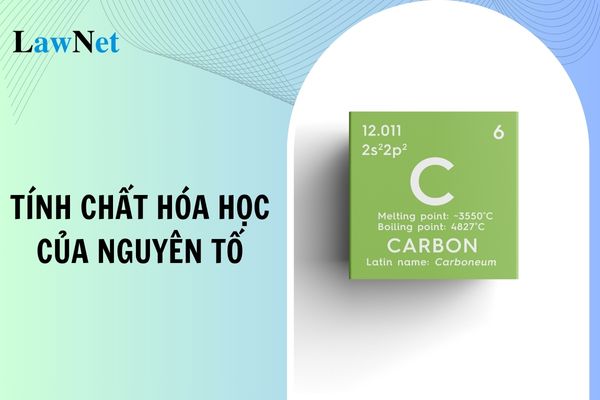Which electron determines the chemical properties of an element? What are requirements for the atomic structure content of grade 10 Chemistry in Vietnam?
Which electron determines the chemical properties of an element?
A chemical property is any characteristic of a material that becomes evident during or after a chemical reaction. The fundamental chemical properties of an element include:
- Metallic nature = the tendency to donate electrons. Denoted as M → Mn+ + ne
- Non-metallic nature = the tendency to accept electrons. Denoted as X + ne → Xn-
- Inertness = neither donating nor accepting electrons under normal conditions; remains inactive like a stone without reacting.
Nearly all elements have their outermost electron shell containing up to 8 electrons. There are some cases as follows:
- If there are 8 electrons in the outermost shell, the electron configuration of these atoms is highly stable. These are usually noble gases.
- Atoms with 1, 2, or 3 electrons in the outermost shell are likely to donate electrons, thus becoming atoms of metallic elements (except for He, H, B).
- Atoms with 5, 6, or 7 electrons in the outermost shell tend to accept electrons, commonly becoming atoms of non-metallic elements.
- Atoms with 4 electrons in the outermost shell can be atoms of either non-metals or metals.
Therefore, the outermost electron shell determines the chemical properties of any element. We can also predict the type of that element if we know the electron configuration of an atom.

Which electron determines the chemical properties of an element? What are requirements for the atomic structure content of grade 10 Chemistry in Vietnam? (Image from the Internet)
What are requirements for the atomic structure content of grade 10 Chemistry in Vietnam?
Based on the general education program in Chemistry issued with Circular 32/2018/TT-BGDDT, the requirements for the atomic structure content of grade 10 Chemistry in Vietnam are as follows:
Components of an Atom
- Explain the components of an atom (an atom is extremely small; an atom consists of two parts: the nucleus and electron shell; the nucleus is made up of protons (p) and neutrons (n); the shell is composed of electrons (e); charge and mass of each type of particle).
- Compare the mass of electrons with protons and neutrons, and the size of the nucleus with the size of the atom.
Chemical Element
- Explain the concept of a chemical element, atomic number, and atomic symbol.
- State the concept of isotopes and atomic mass.
- Calculate the average atomic mass (in amu) based on the atomic masses and the percentage of isotopes provided in the mass spectrum.
Structure of the Atomic Electron Shell
- Explain and compare the Rutherford-Bohr model with the modern model describing the movement of electrons in the atom.
- State the concept of an atomic orbital (AO), describe the shapes of AO (s, p), and specify the number of electrons in one AO.
- Explain the concepts of electron shells, subshells, and the relationship between the number of subshells in a shell. Relate the number of AOs in a subshell, in a shell.
- Write the electron configuration of an atom based on shells, electron subshells, and orbital blocks when knowing the atomic number Z of the first 20 elements in the periodic table.
- Based on the electron configuration of the outermost shell of an atom, predict the basic chemical properties (metallic or non-metallic) of the corresponding element.
Structure of the Periodic Table of Chemical Elements
- Describe the history of the periodic law and the periodic table of chemical elements.
- Describe the structure of the periodic table of chemical elements and explain related concepts (cell, period, group).
- Explain the principles of arrangement in the periodic table of chemical elements (based on electron configuration).
- Classify elements (based on electron configuration: s, p, d, f elements; based on chemical properties: metals, non-metals, noble gases).
Trends in the Variation of Some Atomic Properties of Elements in a Period and a Group
- Explain the trend in atomic radius variation in a period and a group (Group A) (based on the electrostatic attraction of the nucleus for outermost electrons and the increasing number of electron shells in a group from top to bottom).
- Assess and explain the trend in the variation of electronegativity and metallic/non-metallic nature of elements in a period and a group (Group A).
Trends in the Composition and Some Properties of Compounds in a Period
- Assess the trend in the variation of the composition and acid/base properties of oxides and hydroxides in a period. Write illustrative chemical equations.
Periodic Law and Significance of the Periodic Table of Chemical Elements
- State the periodic law.
- Explain the significance of the periodic table of chemical elements: The relationship between the position (in the periodic table of chemical elements) and properties and vice versa.
What is the duration of the grade 10 Chemistry program in Vietnam?
Based on the general education program in Chemistry issued with Circular 32/2018/TT-BGDDT, the duration for the Grade 10 Chemistry program is 105 periods per academic year, taught over 35 weeks. Among these, 70 periods are dedicated to core content. The estimated percentage of time allocated for each content strand is as follows:
| Grade | Topic | Percentage |
| Grade 10 | Structure of the Atom | 18% |
| Periodic Table of Chemical Elements | 13% | |
| Chemical Bonding | 17% | |
| Redox Reactions | 5% | |
| Chemical Energy | 14% | |
| Chemical Reaction Rate | 9% | |
| Group VIIA Elements | 14% | |
| Periodic Review | 10% |

